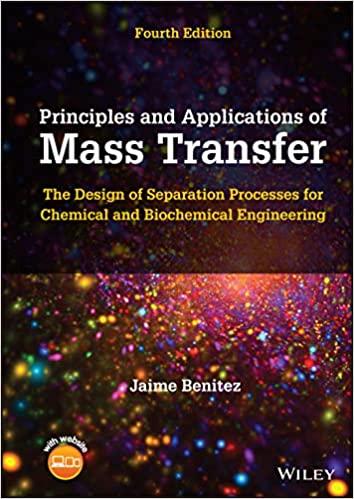A process for making small amounts of hydrogen by cracking ammonia is being considered and residual, uncracked
Question:
A process for making small amounts of hydrogen by cracking ammonia is being considered and residual, uncracked ammonia is to be removed from the resulting gas. The gas will consist of \(\mathrm{H}_{2}\) and \(\mathrm{N}_{2}\) in the molar ratio 3:1, containing \(3 \% \mathrm{NH}_{3}\) by volume, at a pressure of 2 bars and a temperature of \(303 \mathrm{~K}\).
There is available a sieve-tray tower, \(0.75 \mathrm{~m}\) diameter, containing 6 cross-flow trays at \(0.5 \mathrm{~m}\) tray spacing. The perforations are \(4.75 \mathrm{~mm}\) in diameter, arranged in triangular pitch on \(12.5 \mathrm{~mm}\) centers, punched in sheet metal \(2 \mathrm{~mm}\) thick. The weir height is \(40 \mathrm{~mm}\). Assume isothermal scrubbing with pure water at \(303 \mathrm{~K}\). The water flow rate to be used should not exceed \(50 \%\) of the maximum recommended for cross-flow sieve trays, which is \(0.015 \mathrm{~m}^{3} / \mathrm{s} \cdot \mathrm{m}\) of tower diameter (Treybal, 1980). The gas flow rate should not exceed \(80 \%\) of the flooding value.
(a) Estimate the gas flow rate that can be processed in the column under the circumstances described above.
(b) Calculate the concentration of the gas leaving the absorber in part (a).
(c) Estimate the total gas-pressure drop and check the operation for excessive weeping and entrainment.
Data:
Liquid density \(=996 \mathrm{~kg} / \mathrm{m}^{3}\)
Surface tension \(=0.068 \mathrm{~N} / \mathrm{m}\)
Foaming factor \(=1.0\)
Liquid diffusivity \(=2.42 \times 10^{-9} \mathrm{~m}^{2} / \mathrm{s}\)
Gas viscosity \(=1.122 \times 10^{-5} \mathrm{~kg} / \mathrm{m} \cdot \mathrm{s}\)
Gas diffusivity \(=0.23 \mathrm{~cm}^{2} / \mathrm{s}\)
Slope of the equilibrium line, \(m=0.85\)
Step by Step Answer:






